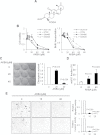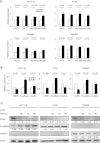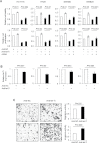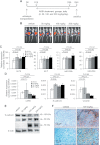Boswellic acid exerts antitumor effects in colorectal cancer cells by modulating expression of the let-7 and miR-200 microRNA family
- PMID: 22983985
- PMCID: PMC3510738
- DOI: 10.1093/carcin/bgs286
Boswellic acid exerts antitumor effects in colorectal cancer cells by modulating expression of the let-7 and miR-200 microRNA family
Abstract
Colorectal cancer (CRC) is a complex disease with genetic and epigenetic alterations in many key oncogenes and tumor suppressor genes. The active principle of a gum resin from Boswellia serrata, 3-acetyl-11-keto-β-boswellic acid (AKBA), has recently gained attention as a chemopreventive compound due to its ability to target key oncogenic proteins such as 5-lipoxygenase and nuclear factor-kappaB. AKBA has been shown to inhibit the growth of CRC cells; however, the precise molecular mechanisms underlying its anticancer activities in CRC remain unclear. We hypothesized that boswellic acids may achieve their chemopreventive effects by modulating specific microRNA (miRNA) pathways. We found that AKBA significantly up-regulated expression of the let-7 and miR-200 families in various CRC cell lines. Both let-7 and miR-200 are putative tumor-suppressive miRNAs. AKBA modulated the expression of several downstream targets of the let-7 and miR-200 families, such as CDK6, vimentin and E-cadherin. These data were further strengthened by miRNA knockdown studies, which revealed that inhibition of let-7i facilitated enhanced cancer cell proliferation, migration and invasion. In addition, AKBA also induced similar modulation of the let-7 and miR-200 downstream genes in CRC tumors orthotopically implanted in nude mice. These results indicate that AKBA-induced antitumor effects in CRC occur, at least partly through the up-regulation of specific miRNA pathways. Our data provide novel evidence that anticancer effects of boswellic acids are due in part to their ability to regulate cellular epigenetic machinery and further highlight the promise for this phytochemical in the preventative and therapeutic applications of CRC.
Figures





Similar articles
-
Novel Evidence for Curcumin and Boswellic Acid-Induced Chemoprevention through Regulation of miR-34a and miR-27a in Colorectal Cancer.Cancer Prev Res (Phila). 2015 May;8(5):431-43. doi: 10.1158/1940-6207.CAPR-14-0354. Epub 2015 Feb 23. Cancer Prev Res (Phila). 2015. PMID: 25712055 Free PMC article.
-
Boswellic acid inhibits growth and metastasis of human colorectal cancer in orthotopic mouse model by downregulating inflammatory, proliferative, invasive and angiogenic biomarkers.Int J Cancer. 2012 May 1;130(9):2176-84. doi: 10.1002/ijc.26251. Epub 2011 Sep 12. Int J Cancer. 2012. PMID: 21702037 Free PMC article.
-
Boswellic acid induces epigenetic alterations by modulating DNA methylation in colorectal cancer cells.Cancer Biol Ther. 2012 May;13(7):542-52. doi: 10.4161/cbt.19604. Epub 2012 May 1. Cancer Biol Ther. 2012. PMID: 22415137 Free PMC article.
-
Pharmacological evidences for cytotoxic and antitumor properties of Boswellic acids from Boswellia serrata.J Ethnopharmacol. 2016 Sep 15;191:315-323. doi: 10.1016/j.jep.2016.06.053. Epub 2016 Jun 21. J Ethnopharmacol. 2016. PMID: 27346540 Review.
-
Oncogenic miRNAs and target therapies in colorectal cancer.Clin Chim Acta. 2020 Sep;508:77-91. doi: 10.1016/j.cca.2020.05.012. Epub 2020 May 11. Clin Chim Acta. 2020. PMID: 32407782 Review.
Cited by
-
Googling the Guggul (Commiphora and Boswellia) for Prevention of Chronic Diseases.Front Pharmacol. 2018 Aug 6;9:686. doi: 10.3389/fphar.2018.00686. eCollection 2018. Front Pharmacol. 2018. PMID: 30127736 Free PMC article. Review.
-
Seeing the Unseen of the Combination of Two Natural Resins, Frankincense and Myrrh: Changes in Chemical Constituents and Pharmacological Activities.Molecules. 2019 Aug 24;24(17):3076. doi: 10.3390/molecules24173076. Molecules. 2019. PMID: 31450584 Free PMC article. Review.
-
The Dual Role of MicroRNAs in Colorectal Cancer Progression.Int J Mol Sci. 2018 Sep 17;19(9):2791. doi: 10.3390/ijms19092791. Int J Mol Sci. 2018. PMID: 30227605 Free PMC article. Review.
-
Genus Boswellia as a new candidate for neurodegenerative disorders.Iran J Basic Med Sci. 2020 Mar;23(3):277-286. doi: 10.22038/IJBMS.2020.35288.8419. Iran J Basic Med Sci. 2020. PMID: 32440312 Free PMC article. Review.
-
Antitumor effects of Andrographis via ferroptosis-associated genes in gastric cancer.Oncol Lett. 2021 Jul;22(1):523. doi: 10.3892/ol.2021.12784. Epub 2021 May 12. Oncol Lett. 2021. PMID: 34025790 Free PMC article.
References
-
- Jemal A., et al. (2010). Cancer statistics, 2010. CA. Cancer J. Clin. 60 277–300 - PubMed
-
- Jemal A., et al. (2011). Global cancer statistics. CA. Cancer J. Clin. 61 69–90 - PubMed
-
- Calin G.A., et al. (2006). MicroRNA signatures in human cancers. Nat. Rev. Cancer 6 857–866 - PubMed
-
- Garzon R., et al. (2009). MicroRNAs in Cancer. Annu. Rev. Med. 60 167–179 - PubMed
Publication types
MeSH terms
Substances
Grants and funding
LinkOut - more resources
Full Text Sources
Medical

